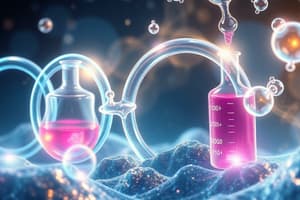Podcast
Questions and Answers
What is the general formula for saturated hydrocarbons?
What is the general formula for saturated hydrocarbons?
- CnH2n
- CnH2n-2
- CnH2n+2 (correct)
- CnHn
What is a characteristic of unsaturated hydrocarbons?
What is a characteristic of unsaturated hydrocarbons?
- They are polar. (correct)
- They are non-polar.
- They are electrolytes.
- They are non-reactive.
What is an example of a saturated hydrocarbon?
What is an example of a saturated hydrocarbon?
- Ethene
- Methane (correct)
- Ethyne
- Propyne
What type of isomerism involves different 3D arrangements of atoms?
What type of isomerism involves different 3D arrangements of atoms?
What is a use of hydrocarbons as energy sources?
What is a use of hydrocarbons as energy sources?
What is a feedstock use of hydrocarbons?
What is a feedstock use of hydrocarbons?
Flashcards are hidden until you start studying
Study Notes
Definition and Classification
- Hydrocarbons are organic compounds consisting of only hydrogen (H) and carbon (C) atoms.
- Classified into two main categories:
- Saturated hydrocarbons (alkanes): single bonds between carbon atoms, general formula CnH2n+2.
- Unsaturated hydrocarbons (alkenes and alkynes): double or triple bonds between carbon atoms, general formula CnH2n (alkenes) and CnH2n-2 (alkynes).
Saturated Hydrocarbons (Alkanes)
- General properties:
- Non-polar, non-reactive, and non-electrolytes.
- Low boiling points, increasing with molecular weight.
- Insoluble in water, soluble in organic solvents.
- Examples:
- Methane (CH4), ethane (C2H6), propane (C3H8), butane (C4H10).
Unsaturated Hydrocarbons (Alkenes and Alkynes)
- General properties:
- Polar, reactive, and non-electrolytes.
- Higher boiling points than alkanes, decreasing with molecular weight.
- Insoluble in water, soluble in organic solvents.
- Examples:
- Ethene (C2H4), propene (C3H6), but-1-ene (C4H8) (alkenes).
- Ethyne (C2H2), propyne (C3H4), but-1-yne (C4H6) (alkynes).
Isomerism in Hydrocarbons
- Structural isomerism: same molecular formula, different arrangements of atoms.
- Stereoisomerism: same molecular formula and bond sequence, different 3D arrangements.
Uses of Hydrocarbons
- Energy sources: fuels for transportation, heating, and electricity generation.
- Feedstock for chemical synthesis: plastics, fertilizers, pharmaceuticals, and dyes.
- Intermediates in industrial processes: lubricants, solvents, and adhesives.
Hydrocarbons
- Defined as organic compounds consisting only of hydrogen (H) and carbon (C) atoms.
Classification of Hydrocarbons
- Divided into two main categories: saturated and unsaturated hydrocarbons.
Saturated Hydrocarbons (Alkanes)
- Characterized by single bonds between carbon atoms.
- General formula: CnH2n+2.
- Properties:
- Non-polar, non-reactive, and non-electrolytes.
- Low boiling points, increasing with molecular weight.
- Insoluble in water, soluble in organic solvents.
- Examples:
- Methane (CH4), ethane (C2H6), propane (C3H8), butane (C4H10).
Unsaturated Hydrocarbons (Alkenes and Alkynes)
- Characterized by double or triple bonds between carbon atoms.
- General formulas: CnH2n (alkenes) and CnH2n-2 (alkynes).
- Properties:
- Polar, reactive, and non-electrolytes.
- Higher boiling points than alkanes, decreasing with molecular weight.
- Insoluble in water, soluble in organic solvents.
- Examples:
- Alkenes: ethene (C2H4), propene (C3H6), but-1-ene (C4H8).
- Alkynes: ethyne (C2H2), propyne (C3H4), but-1-yne (C4H6).
Isomerism in Hydrocarbons
- Structural isomerism: same molecular formula, different arrangements of atoms.
- Stereoisomerism: same molecular formula and bond sequence, different 3D arrangements.
Uses of Hydrocarbons
- Energy sources: fuels for transportation, heating, and electricity generation.
- Feedstock for chemical synthesis: plastics, fertilizers, pharmaceuticals, and dyes.
- Intermediates in industrial processes: lubricants, solvents, and adhesives.
Studying That Suits You
Use AI to generate personalized quizzes and flashcards to suit your learning preferences.




